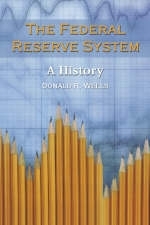
The Federal Reserve System
McFarland & Co Inc (Verlag)
978-0-7864-1880-0 (ISBN)
- Titel z.Zt. nicht lieferbar
- Portofrei ab CHF 40
- Auch auf Rechnung
- Artikel merken
This history of the Federal Reserve begins by giving an overview of American banking practices before the Federal Reserve's formation. The events leading to the Reserve's creation, and its early trials and tribulations, are then documented. Subsequent chapters track the Federal Reserve's history: its role during times of financial and military crisis, its relationship to each presidential administration, and the Fed's evolution as its leadership has changed over the years. The history wraps up with the Alan Greenspan era, explaining major changes in the institution's operating procedures since the 1980s. An appendix lists all members of the Federal Reserve Board of Governors, from its formation until 2003.
Donald R. Wells, professor emeritus of economics from the University of Memphis, has written extensively in the areas of free banking, the Canadian Banking System, and the reaction of the U.S. and Canadian banking systems to periods of depression. He lives in Plano Texas.
Table of Contents
Preface
1. U.S. Banking before the Federal Reserve
2. The Aldrich-Vreeland Act Prevents a Panic in 1914
3. Original Uncertainty Regarding Exercise of Fed Authority
4. The Federal Reserve’s Role in World War I
5. The Discovery of a New Tool for the Federal Reserve
6. The Fed in the 1920s
7. The Fed in the 1929–1933 Contraction
8. Policy Changes in the Roosevelt Administration
9. The Fed’s Role in World War II
10. The Fed Between World War II and the Korean War
11. The Korean War and the Accord with the Treasury
12. “Bills Only” as an Act of Independence
13. Operation Twist and President Kennedy’s Tax Cut
14. Chairman Martin’s Battle with President Johnson Over Inflation
15. Nixon Replaces Martin with Burns and Inflicts Price Controls on the Economy
16. Supply Shocks in the 1970s Make Unemployment and Inflation Worse
17. Carter Replaces Burns with Miller and Inflation Worsens
18. The Volcker Era Begins and the Fed Gets Control Over All Banks
19. Volcker’s Fed Slows Inflation at a Cost
20. Volcker Is Reappointed but There Are Changes on the Board
21. The Greenspan Era Begins
22. The Fed’s Response to the Thrift Crisis
23. Economists Dominate the Board Under Greenspan
24. Changes in the Fed’s Operating Procedure after the 1980s
Conclusion
Appendix A: Membership of the Board of Governors of the Federal Reserve System, 1913–2003
Appendix B: Persons Serving as Chairman of the Board of Governors
Bibliography
Index
| Erscheint lt. Verlag | 30.8.2004 |
|---|---|
| Zusatzinfo | bibliography, appendices, index |
| Verlagsort | Jefferson, NC |
| Sprache | englisch |
| Maße | 152 x 229 mm |
| Gewicht | 313 g |
| Themenwelt | Wirtschaft ► Betriebswirtschaft / Management ► Finanzierung |
| Wirtschaft ► Betriebswirtschaft / Management ► Marketing / Vertrieb | |
| Betriebswirtschaft / Management ► Spezielle Betriebswirtschaftslehre ► Bankbetriebslehre | |
| ISBN-10 | 0-7864-1880-X / 078641880X |
| ISBN-13 | 978-0-7864-1880-0 / 9780786418800 |
| Zustand | Neuware |
| Informationen gemäß Produktsicherheitsverordnung (GPSR) | |
| Haben Sie eine Frage zum Produkt? |
aus dem Bereich


